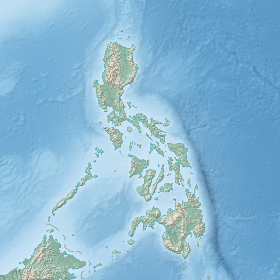
Back Isla nin Frayle BCL El Fraile Island CEB Fort Drum (El Fraile) Czech El Fraile (Insel) German Isla El Fraile (Filipinas) Spanish فورت درام (فیلیپین) Persian Fort Drum French El Fraile ILO フォート・ドラム (エル・フレイル島) Japanese ഫോർട്ട് ഡ്രം (എൽ ഫ്രൈലെ ദ്വീപ്) Malayalam
| Fort Drum | |
|---|---|
El Fraile Island | |
| Part of Harbor Defenses of Manila and Subic Bays | |
| Near Cavite City in Manila Bay in the Philippines | |
 Fort Drum in 1983, with the battleship USS New Jersey (BB-62) in the background | |
| Coordinates | 14°18′18″N 120°37′50″E / 14.30500°N 120.63056°E |
| Type | Island-fort |
| Height | Top deck is 40 feet (12 m) above water at mean low tide |
| Site information | |
| Owner | Philippines |
| Controlled by | Cavite City |
| Open to the public | No |
| Condition | Ruins |
| Site history | |
| Built | 1909–1914 |
| Built by | United States Army Corps of Engineers |
| In use | 1941-1945 |
| Materials | Reinforced concrete |
| Battles/wars | |
| Events | World War II |
| Garrison information | |
| Occupants | None |
Fort Drum, also known as El Fraile Island (Tagalog: Pulo ng El Fraile), is a heavily fortified island situated at the mouth of Manila Bay in the Philippines, south of Corregidor Island. Nicknamed a "concrete battleship",[1] the reinforced concrete sea fort, shaped like a battleship, was built by the United States in 1909 as one of the harbor defenses at the wider South Channel entrance to the Bay during the American colonial period.
It was unique among forts built by the United States between the American Civil War and early World War II, as it was a sea fort with turrets. It was captured and occupied by the Japanese during World War II, and was recaptured after U.S. forces ignited petroleum and gasoline in the fort, the conflagration killing 68 Japanese soldiers and leaving it permanently out of commission. Due to the high temperature caused by the conflagration, it took five days before U.S. soldiers could enter the fortress.
The fort, now abandoned, was named after Brigadier General Richard C. Drum,[2] who served with distinction during the Mexican–American War and the American Civil War, and died on October 15, 1909, the year of the fort's construction. The island and the other former harbor defenses of Manila Bay fall under the jurisdiction of Cavite City.[3]
- ^ Brimelow, Benjamin (August 24, 2021). "The US Army's 'concrete battleship' in the Philippines saw some of World War II's fiercest fighting". Business Insider. Retrieved February 2, 2022.
- ^ Lewis, p. 96.
- ^ U.S. Army (1916). "United States Military Reservations, National Cemeteries, and Military Parks", pg. 344. Government Printing Office, Washington.
